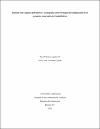| dc.contributor.advisor | Jaramillo-Acosta, Laura Marcela |
| dc.creator | Aguilar-Gil, Karol Fabiana |
| dc.creator | Cifuentes-Fajardo, Julio Cesar |
| dc.date.accessioned | 2023-09-20T12:17:53Z |
| dc.date.available | 2023-09-20T12:17:53Z |
| dc.date.created | 2022-06-18 |
| dc.identifier.uri | http://repositorio.uniagustiniana.edu.co/handle/123456789/2279 |
| dc.description | La presente investigación consta del estudio y la exploración de la relación entre los espacios polivalentes y la escenografía y como un recurso para precisar las estrategias de diseño con el fin de elaborar un modelo arquitectónico de una plaza de mercado en el barrio de la Candelaria en la ciudad de Bogotá D.C. El desarrollo metodológico de la investigación se realizó por tres etapas; La primera etapa tiene como propósito reconocer las tipologías comerciales que se localizan en el territorio a partir de identificar los contenidos que poseen, las cuales determinan las diferentes configuraciones espaciales de los elementos de la escenografía, la segunda etapa consiste en relacionar los escenarios de estudio por medio del funcionamiento del espacio a través de otorgarle cualidades flexibles que articulen y liberen el espacio genérico.
De tal manera se abordaron las 2 primeras etapas de la investigación que ayudan a plantear un modelo de una plaza de mercado, donde surge de la tercera etapa que formula los aspectos sociales, urbanos y arquitectónicos que configuran diferentes escenarios polivalentes entre el interior y exterior a partir de la relación entre las variables. |
| dc.description.abstract | This research consists of the study and exploration of the relationship between multipurpose spaces and scenography and as a resource to specify design strategies to develop an architectural model of a market square in the Candelaria neighborhood in Bogotá D.C. The methodological development of the research was carried out in three stages; The first stage aims to recognize the commercial typologies that are located in the territory by identifying the contents they have, which determine the different spatial configurations of the elements of the scenography, the second stage consists of relating the study scenarios through the operation of the space through granting flexible qualities that articulate and release the generic space.
In this way, the first 2 stages of the research were addressed that helped to propose a marketplace model. In contrast, it arises from the third stage that formulates the social, urban, and architectural aspects that configure different multipurpose scenarios between the interior and exterior based on the relationship between the variables. |
| dc.format.mimetype | application/pdf |
| dc.language.iso | spa |
| dc.rights | Attribution-NoDerivatives 4.0 Internacional |
| dc.rights | Attribution-NonCommercial-NoDerivatives 4.0 Internacional |
| dc.rights.uri | http://creativecommons.org/licenses/by-nc-nd/4.0/ |
| dc.subject | Escenografía |
| dc.subject | Configuración |
| dc.subject | Relación |
| dc.subject | Funcionamiento |
| dc.subject | Flexibilidad |
| dc.title | Relación entre espacios polivalentes y escenografía, como estrategias de configuración, en los escenarios comerciales de Ciudad Bolívar. |
| dc.type | info:eu-repo/semantics/bachelorThesis |
| dcterms.source | instname:Universitaria Agustiniana |
| dcterms.source | reponame:Repositorio Institucional UniARI |
| dc.rights.accesRights | info:eu-repo/semantics/restrictedAccess |
| dc.rights.acceso | Restringido (Temporalmente bloqueado) |
| dc.subject.keyword | Scenography |
| dc.subject.keyword | Configuration |
| dc.subject.keyword | Relationship |
| dc.subject.keyword | Functioning |
| dc.subject.keyword | Flexibility |
| dc.type.hasVersion | info:eu-repo/semantics/acceptedVersion |
 This work is licensed under a Creative Commons Reconocimiento-NoComercial 4.0.
This work is licensed under a Creative Commons Reconocimiento-NoComercial 4.0.


